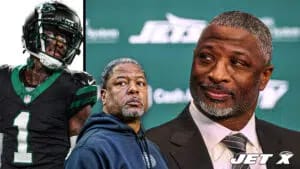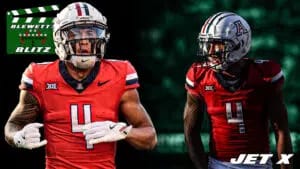We have seen other QBs who lack height struggle over the middle of the field
At the 2021 BYU Pro Day, prior to becoming the No. 2 overall pick to the New York Jets, Zach Wilson measured in at 6’2 1/10″ tall.
It’s hard to know if the Jets considered that before they took him. 6’2″ is not exactly short for a quarterback; after all, guys like Lamar Jackson, Dak Prescott, Aaron Rodgers, Patrick Mahomes, and Deshaun Watson are all listed there.
However, when you consider that the average NFL offensive and defensive linemen are at least 6’4 3/4″, it makes you wonder whether the bar is set a little too low. Can a 6’2″ QB really see over a 6’5″ offensive or defensive lineman right in front of his face?
Throwing over the middle
We’ve definitely seen quarterbacks like Kyler Murray, Russell Wilson, and Jalen Hurts struggle to throw over the middle of the field in past seasons because they can’t see over the linemen. Let’s take a look at quarterback percentages of throwing over the middle of the field so far in 2022, though.
Per NFL Next Gen Stats, Tua Tagovailoa actually leads all 35 qualified quarterbacks with 39.8% of his throws coming over the middle this season. He is listed at 6’1″ on the Dolphins’ website but measured an even 6’0″ at the Combine.
Jimmy Garoppolo, at 6’2 1/4″, is second at 39.0%, and he’s made a career throwing the majority of his passes in the middle third. Mac Jones, at 6’2 5/8″, is fourth at 34.8%. Surprisingly, Russell Wilson is seventh at 32.5% despite having often thrown fewer attempts over the middle in the past. Lamar Jackson, Patrick Mahomes, Baker Mayfield (6’0 5/8″), and Andy Dalton (6’2″) are also in the top half.
Among quarterbacks who throw over the middle the least are Mitchell Trubisky (6’2 1/8″), Jalen Hurts (6’1″), Cooper Rush (6’2 5/8″), Geno Smith (6’2 3/8″), and Justin Fields (6’2 3/4″). However, Joe Burrow (6’3 1/2″) is 25th, followed by Jameis Winston and Davis Mills, another two above-6’3″ QBs. Kenny Pickett and Kirk Cousins round out the group of below-average throwers over the middle.
Zach Wilson, incidentally, is 18th, throwing the ball over the middle 28.9% of the time. That’s just about dead average.
This season, we do not see any particular statistical patterns between quarterback height and preference in throwing over the middle.
Perhaps the preference to throw over the middle has to do not with height, but with how much pressure the quarterback faces up the middle. If the defense has penetration up the middle, it’s certainly going to be hard for any quarterback to see over them. Even a 6’5″ quarterback will struggle to see over a 6’5″ defensive or offensive lineman who is right in his face.
Though the stat isn’t perfect, we can estimate each team’s pressure rates up the middle by combining the total pressures allowed and pass block snaps of their guards and center. Here are the top and bottom five teams in terms of pressure rate up the middle.
| Rank | Team | QB | QB height (inches) | Pressure rate up the middle (Guards + center) | QB over-the-middle rate (rank) |
|---|---|---|---|---|---|
| 1 | Bucs | Tom Brady | 76.4 | 3.40% | 37.9% (3/35) |
| 2 | Panthers | Baker Mayfield | 72.63 | 3.61% | 30.1% (12) |
| 3 | Packers | Aaron Rodgers | 74 | 3.74% | 28.5% (19) |
| 4 | Ravens | Lamar Jackson | 74.25 | 3.78% | 32.3% (8) |
| 5 | Jaguars | Trevor Lawrence | 77.63 | 3.83% | 29.2% (16) |
| 28 | Jets | Zach Wilson | 74.1 | 5.90% | 28.9% (18) |
| 29 | Commanders | Carson Wentz | 77.25 | 6.23% | 27.6% (23) |
| 30 | Rams | Matthew Stafford | 74.25 | 6.42% | 27.9% (21) |
| 31 | Bears | Justin Fields | 74.75 | 6.59% | 25.2% (29) |
| 32 | Titans | Ryan Tannehill | 75.88 | 7.06% | 32.2% (9) |
While there doesn’t appear to be an obvious correlation that jumps out, it does seem that the quarterbacks with less pressure up the middle are somewhat more willing to throw over the middle.
Tua, the quarterback throwing over the middle the most this season, has a pressure rate up the middle that ranks 20th out of 32 teams. Jimmy Garoppolo, who is second, has the eighth-lowest pressure rate up the middle. Mac Jones is fourth and has the 11th-lowest pressure rate. Again, there’s somewhat of a connection, but it’s not terribly strong.
The main takeaway from this may be that for Zach Wilson, his struggles in stepping up could be connected to high pressure rates straight up the middle. That is most likely directly correlated with the fact that Laken Tomlinson has been one of the worst guards in the league this season. Wilson appears to be seeing ghosts due to that constant barrage.
At what height does it even matter?
As I said before, you don’t hear too much about a quarterback’s height if he is at least 6’2″. Shorter than that, you’ll start hearing rumblings, such as about Kyler Murray, Jalen Hurts, and Russell Wilson. To many, Wilson shattered the narrative that a shorter quarterback couldn’t play the position at a high level, as he is only 5’11” but put up a possible Hall of Fame career with the Seahawks.
Zach Wilson may appear shorter than 6’2 1/10″ on the field, but that’s partially a function of his slighter frame overall. You can see in this picture of him next to the 6’3″ Lawrence Taylor that Wilson is not all that much shorter than him, if at all.
Have QBs 6’2″ and under succeeded in the NFL?
Looking at the list of 26 pure quarterbacks in the Hall of Fame, we find that more than half of them were listed at 6’2″ or under. Sonny Jurgensen was 5’11”; Len Dawson, Fran Tarkenton, and Y.A. Tittle were 6’0″, with Steve Young in the same range; Bobby Layne, Otto Graham, Norm Van Brocklin, Bob Waterfield, Bart Starr, and Johnny Unitas were 6’1″, with Kurt Warner coming in that range; and Joe Montana and Joe Namath were both 6’2″, with Brett Favre coming in at 6’2 3/8″.
You do notice that many of these quarterbacks played in the old NFL eras of the ’40s, ’50s, and ’60s. It’s possible that NFL players as a whole were shorter then, but it could just be that due to the differing nature of the game, the height of a quarterback was not quite as important.
In more recent times, Drew Brees is a certain Hall of Famer who came in at 6’1 3/10″. The aforementioned Russell Wilson is certainly near if not at a Hall of Fame level at 5’11”, and Aaron Rodgers is there at 6’2″. Watson, Jackson, Prescott, and Mahomes have all put together excellent careers thus far while standing at 6’2″.
Sure, Wilson is at the shorter end of 6’2″. However, so is Patrick Mahomes.
Admittedly, many of the top QBs in the NFL stand at 6’3.5″ or above, including Tom Brady, Joe Burrow, Josh Allen, Justin Herbert, and Matthew Stafford. However, Tua and Hurts, standing at 6’0″ and 6’1″, respectively, are putting up career years. Rodgers and the other above-mentioned QBs have done just fine.
Stepping up in the pocket
Here is where we get to the crux of the matter. Zach Wilson has struggled immensely with stepping up in the pocket. At the first sign of pressure (real or imagined), Wilson tends to bail the pocket.
I don’t believe that this is a height issue, although it’s possible that putting more distance between himself and the linemen will give him more space to see. I believe it’s a weight and frame issue.
Wilson is one of the slighter quarterbacks in the NFL. He came in listed at 209 pounds, which is small for a 6’2″ quarterback. According to Robert Saleh and Wilson himself, he put on about 10-12 pounds of muscle in the offseason, and he does look somewhat stockier. However, having sustained two knee injuries in just 17 career starts, Wilson is afraid of taking a pounding.
Lamar Jackson currently weighs in at 230 pounds, a weight he’s worked hard to build up to for durability reasons. Patrick Mahomes is listed at 225 but appears larger than that, and his build is much broader than Wilson’s. Russell Wilson’s weight varies by which site you check, but he’s generally acknowledged to be around 215-220 pounds, which he carries on a stockier frame. Jalen Hurts has gotten up to 223. Rodgers is 225. Tua is more similar to Zach at 216, but even he appears broader (and he has also suffered several injuries already). Dak Prescott is at 229.
Meanwhile, Kyler Murray weighs 194 pounds. We’ve seen Murray both get injured and run around rather than stepping up in the pocket. Although he’s played at a Pro Bowl level in the past, there is a certain aversion to putting himself in harm’s way. He’d also circle around vs. staying in the pocket to deliver the ball.
Batted passes
It’s natural to assume that shorter quarterbacks have more passes batted down. Indeed, Jimmy Garoppolo, Baker Mayfield, Kyler Murray, Lamar Jackson, Russell Wilson, Jalen Hurts, Justin Fields, and Zach Wilson are all in the top 12 out of 35 QBs in this category.
However, Josh Allen has been one of the leaders in the NFL in this category over the past few seasons, and he’s tied for first this season with 11 batted passes. That could conceivably have to do with a spy approach to defending Allen, but it also casts suspicion on the idea that height is the main factor that causes batted passes. Joe Burrow and Justin Herbert are tied for third with 10. Joe Flacco, at 6’6″, had four passes batted down on just 155 attempts. Clearly, there is more at play here.
However, the fact that so many quarterbacks who are not particularly tall have many passes batted down definitely makes sense. It’s easier for linemen to get their hands on the ball when it’s coming from a lower trajectory. That’s just one of the realities that a shorter quarterback will have to deal with, and it’s one that Zach Wilson has suffered with from time to time.
So is Wilson’s height getting in the way?
The condensed answer appears to be “no, for the most part.” Wilson does have more passes batted down due to his height, but he throws over the middle at an average rate. His pressure rate up the middle seems to affect him far more than his height, and that could be partially due to his slighter frame and recent injury history.
What can be taken out of this? To me, it means that a 6’2″ height shouldn’t be overly concerning for a highly-regarded prospect. Yes, batted passes may be somewhat of an issue, but it’s not stark enough to warrant undue attention. Shorter than 6’2″ could be a larger issue, but quarterback frame and willingness to take a hit is more important.
For this season, it means that the Jets need to a) consider using their backs to provide pass protection help inside rather than outside and b) work with Wilson on moving forward rather than backward.
In short: QB height is somewhat overrated.









